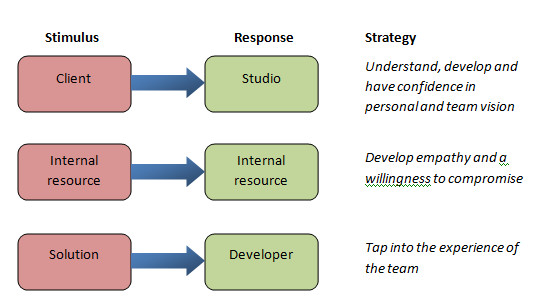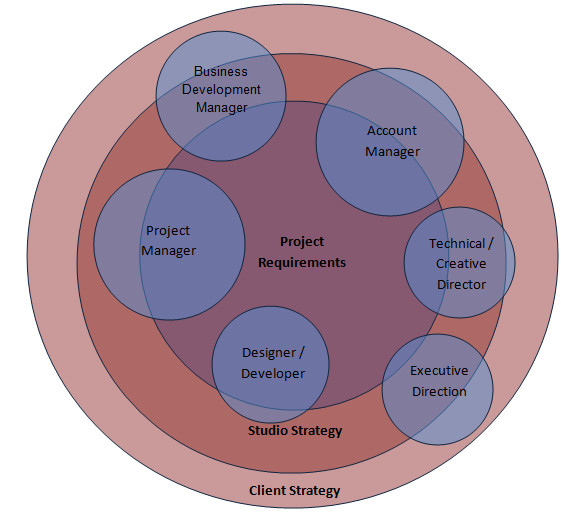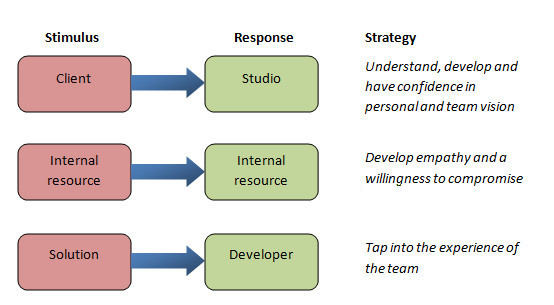Covey’s Seven Habits for the Digital Agency – Habit 1: Be proactive
We recently started a morning “breakfast club” in the studio, and first topic is the desktop reading of Covey’s .Seven Habits of Highly Effective People. His first principle of being proactive has unique application to a digital studio such as ours.
Between stimulus and response
The first of two core concepts that stand out from the first habit is that of managing the gap between stimulus and response. Against the impacting foil of a Jewish philosopher during the Nazi holocaust, Covey describes how even in the most challenging situations we have the freedom to choose how we react to external stimuli. I would not go so far as to compare our industry to a concentration camp. However, the application of this concept in a high-pressure service organisation like a digital agency is obvious when considering three stakeholder relationships involved.

- Client to studio
The stimulus / response gap is most evident when there is a power imbalance such as that seen in the market-prescribed client / vendor relationship. The comparison to Covey’s prison analogy is not far off when a client-facing manager is faced with an aggressive client that appears to have the power of positional life and death. A key to controlling our response in these situations is holding to a personal vision of who we are as individuals and as a team.We are competent and capable professionals that perform highly complex tasks. We respond to the best of our ability to achieve client objectives. When there is a need, we do whatever it takes. However, we expose our insecurities when we allow our response to match the tone of stimuli threatening to contradict the vision of ourselves we know to be true. - Internal resources
To use an analogy from the recent winter Olympics, managing conflicting priorities in a digital agency with multiple project and account managers can be a bit like ice hockey with 5 teams, 3 goals and 10 pucks during an earthquake, all choreographed each morning to a perfect figure skating routine. We’re all on the same team, but we also have our own priorities that can change with a single phone call. While personal awareness helps in the previous client stimuli, managing our responses to each other is easier with an understanding and empathy of the other person’s position. - Solution to developer
A final stakeholder we consider in a digital company is the sentient entities of the solutions themselves. As mentioned, what we do is complex. Configuring new technology for browsers developed almost a decade ago or building a solution to accommodate six billion combinations of product configurations takes a bit of thought. Apart from the previous strategies of awareness of self or of others, we can manage our response to the stimuli of solution challenges by tapping into on the experience and knowledge of our team to overcome issues as they arise.
Circle of influence, circle of concern
The second concept to be applied to a digital agency highlighted in Habit One is that of the distinction between our circle of influence and our circle of concern. Covey again highlights the obvious by explaining the distinction between that which we have influence over, and that which we are concerned about but cannot influence. Covey goes on to say that the more we take responsibility for our circle of influence, the more our influence increases into our circle of concern.
The diagram below outlines potential circles of influence for different roles within a digital agency. The principles outlined above prove true for each of the roles. As internal staff act responsibly with project requirements, those staff will be sought after to speak into studio strategy. In the same manner, the better able the studio as a whole and staff associated with a particular account are able to meet project requirements, the more the studio and those client-facing individuals will be asked to speak into client strategy.

Another principle highlighted by the diagram is the cumulative nature of influence within the studio as each role supports the influence of the other. The ability of the executive directors can be cut off by a designer or developer not meeting project requirements. By the same token, a project manager’s ability to have influence is greatly facilitated by a technical director focusing on what needs to be done for the project.
The Wrap
As you look at your own role, to what degree do you apply these common sense principles in your organisation? You can probably think of a time in the last 4 weeks where your response has been dictated by the stimulus. You can also probably identify a situation where you lost influences based on focusing on things that were a concern but over which you had no control.
Those are good to consider, in that it means there is opportunity for improvement. I would be interested in your thoughts about how we can practically apply change in these areas and what impact it would have on your organisation.


3 thoughts on “Covey’s Seven Habits for the Digital Agency – Habit 1: Be proactive”
Comments are closed.